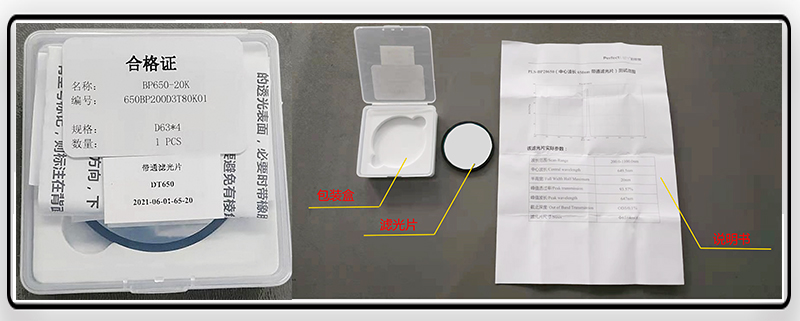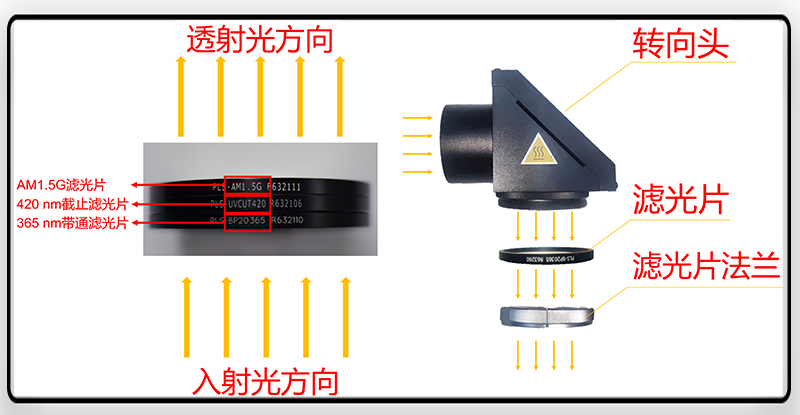Optical Filters are optical components that attenuate light intensity, modify spectral composition, or define the vibration plane. Used as common accessories in photochemical experiments, filters achieve specific filtering effects by depositing different film materials on glass or quartz substrates.
In the field of photochemical research, commonly used optical filters can be classified into three main types: Cutoff Filters, Bandpass Filters, and Solar Spectrum Calibration Filters.
Cutoff Filters, also known as CUT filters, block wavelengths below a target wavelength. There are four wavelength models: UVCUT 400, UVCUT 420, CUT 700, and CUT 800. The spectral profiles are shown in Figure 1(a).
Bandpass Filters, also known as DT filters, allow the passage of light around the central wavelength of the target band. There are a total of 15 single-wavelength models, including DT 350, DT 365, DT 380, DT 400, DT 405, DT 420, DT 435, DT 450, DT 475, DT 500, DT 520, DT 550, DT 600, DT 650, and DT 700. The spectral profiles are shown in Figure 1(b).
Solar Spectrum Calibration Filters are used to match xenon lamp spectra to the AM1.5G standard solar spectrum. The spectral profile is shown in Figure 1(c).

Figure 1. (a) Cutoff Filters, (b) Bandpass Filters, (c) AM1.5G Standard Solar Spectrum and Xenon Lamp with AM1.5G Filters.
The packaging of optical filters is shown in Figure 2, including a packaging box, filters, and an instruction manual.
The packaging box includes a certificate of conformity and labels indicating the filter's name, number, specifications, and quantity.
The instruction manual contains usage instructions, spectral charts, and actual parameters of the filters.

Figure 2. Filter Packaging Box, Filters, and Accessories.
I. Installation and Use of Optical Filters
Installing Filters
1) Wear gloves and carefully open the packaging box to retrieve the filter and instruction manual.
2) Confirm the filter model: Check the numeric identification on the outer ring of the filter, as shown in Figure 3. The framed number represents the filter's wavelength. Ensure that the filter model matches the one indicated in the instruction manual and on the packaging box. Also, check if the spectral chart and specifications in the manual meet the experimental requirements.
3) Determine the filter orientation: When viewing the text on the outer ring of the filter, the top side is the direction for transmitted light, and the bottom side is for incident light, as shown in Figure 3.
Note: Filter transmission is directional, so do not invert it. Be sure to confirm the direction of transmission before installing the filter.
4) Secure the filter: When installing and securing the filter, loosen the filter flange in front of the xenon lamp light source, place the filter in the flange with the orientation of incident and transmitted light as shown in Figure 3, and then tighten the filter flange just enough to prevent the filter from coming loose. Do not overtighten to avoid difficulties in removing the filter when needed.

Figure 3. Filter Identification and Installation Schematic.
5) Storing Filters: After using the filter, remove it, wrap it in clean lens cleaning paper or lens cleaning tissue, and place it back in the packaging box with the corresponding label. The packaging box should be stored in a dry cabinet.
II. Precautions for Using Optical Filters:
1. During the use of filters, avoid scratching them with sharp objects. If there are scratches on the filter glass, replace the filter promptly.
2. Wear gloves when handling filters to prevent skin oils from corroding the filter glass.
3. When picking up and putting down filters, only touch the outer ring of the filter to avoid direct contact with the filter glass.
4. Place filters on soft, clean surfaces to prevent scratching the filter glass.
5. If there are stains or fingerprints on the filter glass, you can use anhydrous ethanol or a small amount of ether-soaked lens cleaning paper to wipe from the center of the filter outward.
